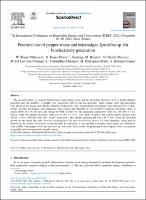Potential use of pepper waste and microalgae Spirulina sp. for bioelectricity generation

View/
Author(s)
Rojas-Villacorta, W.
Rojas-Flores, S.
Benites, Santiago M.
Delfín-Narciso, D.
De La Cruz-Noriega, M.
Cabanillas-Chirinos, L.
Rodríguez-Serin, H.
Rebaza-Araujo, S.
Date
2023Metadata
Show full item recordPublisher
Elsevier
Journal
Energy Reports
Abstract
The research aimed to generate bioelectricity using pepper waste and the microalgae Spirulina sp by a double-chamber microbial fuel cell (dcMFC). A dcMFC was constructed with Cu and Zn electrodes, where organic waste and microalgae were placed in the anodic and cathodic chambers, respectively. Also, electrochemical parameters were measured for 35 days. Finally, possible electrogenic microorganisms were isolated and identified. It was possible to generate maximum values of current (6.04414 ± 0.2145 mA) and voltage (0.77328 ± 0.213 V). The maximum conductivity value was 134.1636 ± 7.121 mS/cm, while the internal resistance value was 83.784
. The values of power and current density reached were 584.45 ± 19.14 mW/cm 2 and 5.983 A/cm 2, respectively. The optimal operating pH was 4.59 ± 0.14. From the microbial growth on the anode, the yeast Yarrowia phangngaensis (1) and Pseudomonas stutzeri (2) were identified, which may be involved in the transfer of electrons to the electrode. In conclusion, it was possible to generate clean energy in a laboratory-scale dcMFC when pepper waste and Spirulina sp. were used. These results are promising because organic waste can generate sustainable and environmentally friendly energy.
Type
info:eu-repo/semantics/article
Rights
info:eu-repo/semantics/openAccess
Language
eng
Collections
- Ingeniería Ambiental [83]

